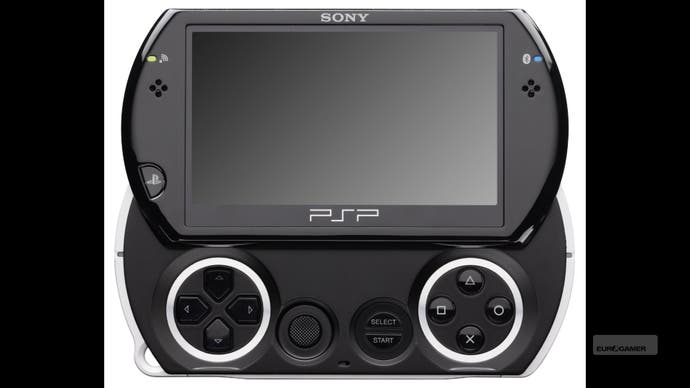PSPgo
We have an extended go go.
It was the worst kept secret since, I dunno, hands. It was a secret so poorly kept that, having already kept it poorly enough that everyone knew about it anyway, Sony even managed to announce it by accident, on video, a few days before E3. It was a secret so poorly kept that Sony America boss Jack Tretton joked he was surprised anyone turned up. But now we actually have a PSPgo in the office, it turns out the shy old girl was keeping a few of her own secrets.
But before we get onto that, let's remind each other what we're on about. The PSPgo launches on 1st October for £224.99 / €249.99, although you can trim that down by shopping around. It's fundamentally the same system as the PSP-3000 in software terms, notwithstanding a few nips and tucks in the firmware, but instead of UMD games it feasts exclusively on downloads, stored either on the internal 16GB flash disk or Memory Stick.
Externally, however, it's a radical shake-up, as you can see in today's Eurogamer TV Show. Whereas the two iterations of the Slim & Lite concentrated on reducing bulk through internal miniaturisation, the PSPgo adds to that with a slide-screen design that shields the d-pad, analogue nub, start/select and face buttons from view when closed, and a smaller, 3.8-inch LCD screen. With the UMD drive removed, the whole thing is considerably smaller even than the PSP-3000 - losing about half a centimetre each in width and height and a whopping five or so across its length. Next to the original PSP, it is as ants appear to man.
Despite the reduction in size and weight, the PSPgo also packs in some new functionality. Bluetooth support means that you can sync it up to a headset, which will be handy for SOCOM fans, but it also means that you can make it talk to a PS3 controller - either Sixaxis or DualShock 3. This means that, with a component cable making use of the surviving external display support, games like WipEout Pulse and Ridge Racer 2 - or indeed anything else - can be played as though on a home console. For those of you who fancy taking advantage of the PlayStation Store's growing volume of PSone games, that's an interesting prospect.

Not that it's unpleasant to play games natively. The compact design means that the analogue nub has had to be positioned closer to the centre next to start/select, inside the d-pad and face buttons, which are in more comfortable positions. The nub itself is smaller, and I'm finding it easier to grip than the old one, while the now-microswitched d-pad and face buttons (you know, clicky) are likeable enough alternatives to the squidgy originals. Shoulders are fine, and the original external controls - the PS, volume, brightness and music buttons, and power and Wi-Fi locks - can all be found distributed around the exterior, along with all sorts of LEDs.
As with all handhelds, however, there are some quirks to consider. For instance, there's no raw USB port anywhere on the exterior any more. Not mini-USB, not micro-USB. There's no slot for your existing PSP component cable either. Instead there's a presumably-all-purpose new port for the PSPgo's power connector, which is about the same thickness as the iPhone/iPod charging cable, about three quarters the width, and terminates in a male USB connector. This can either go into your PC or PS3 for file transfers and charging, or into a regular-looking AC adapter. Expect some replacement cables to arrive on the market around launch, then, and probably a dock.








